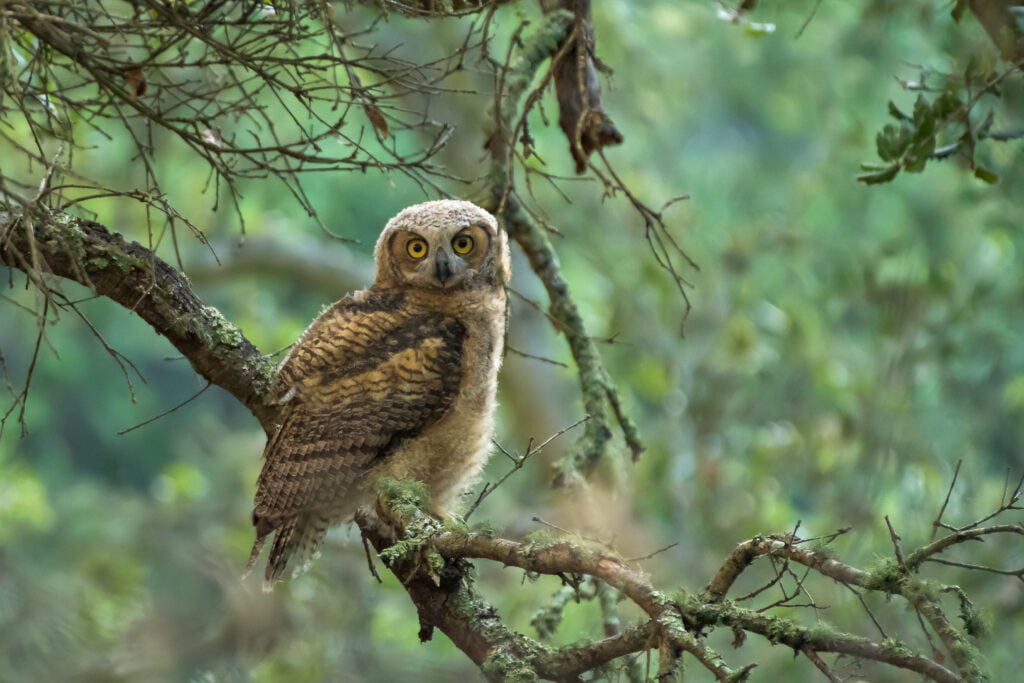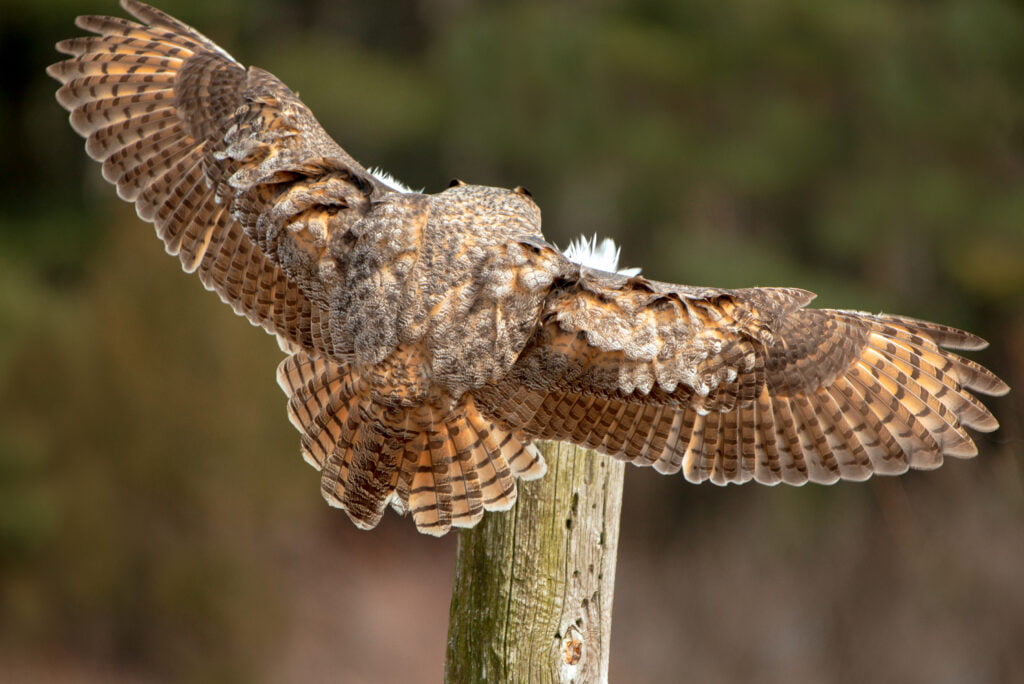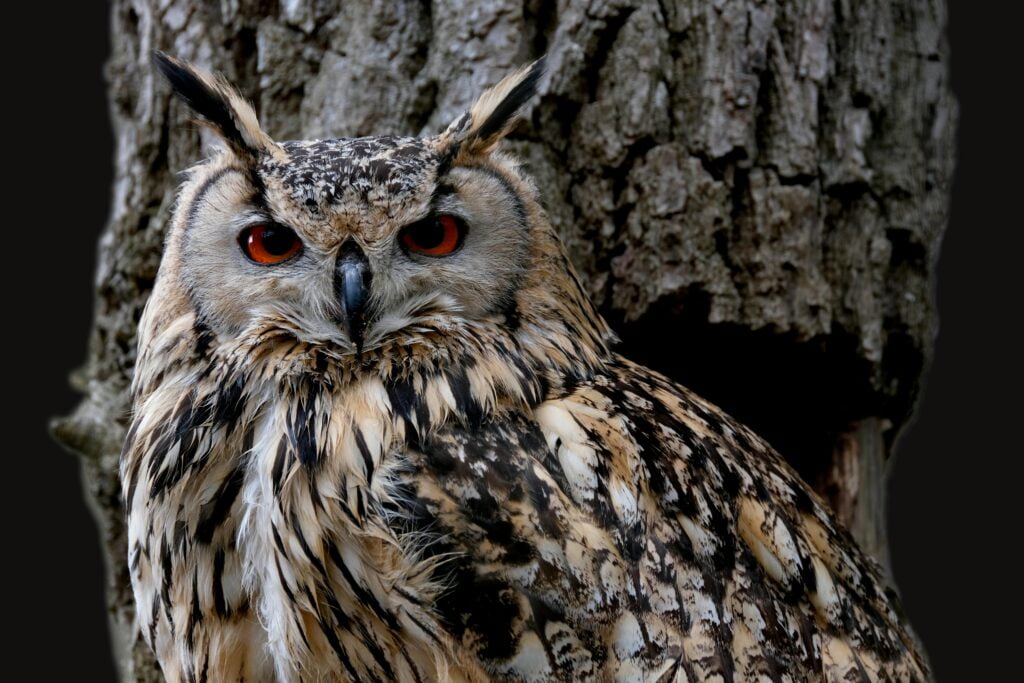What is the Most Common Owl in New York State

An iconic silent guardian of the trees, the Great Horned Owl is the king of New York State’s magical forests and vibrant parks. This majestic animal mesmerizes the audience with its terrifying roar, unusual tufts of feathers on the ears and deep golden eyes. Come explore the wonderful world of the Great Horned Owl with me; It is the most common and beloved owl species in New York.
The Great Horned Owl: A Portrait of Majesty:
The Great Horned Owl is a silent protector that watches over the forests and woods of New York. This magnificent bird of prey mesmerizes everyone it meets with its imposing stature, attractive appearance and unique hunting abilities. Come join me as I delve deeper into the beauty and history of the Great Horned Owl, a symbol of New York’s rich natural history.
The Regal Appearance:
Imagine a shadowy creature with horn-like wings on top of its head, red eyes that seem to peer into the darkness. As its scientific name (Bubo virginianus) suggests, the Great Horned Owl exudes a sense of majestic power and sophistication. Due to its immense height and fearsome appearance, it is considered one of the most spectacular predators in the natural world.
Adaptations for Survival:
In addition to its remarkable appearance, the great horned owl has a set of adaptations that have been refined over many generations of evolution. The owl’s extraordinary effectiveness as a nocturnal hunter is, in large part, due to its sharp claws, which allow it to capture prey with pinpoint accuracy; its excellent vision, which allows it to see in the dark; and its silent flying wings, which allow it to fly silently.
Hunting Mastery:
In the dark, the Great Horned Owl reveals its hunting skills, skillfully pursuing its prey with all the subtlety in the world. This fearsome predator can snatch any animal, no matter how small, even birds and large mammals. It searches for food for itself and its offspring silently and precisely.
Symbolism and Mythology:
The Great Horned Owl is a mythical creature that has played an important role in many myths and legends around the world. It contains the essence of mysticism and mystery, and is revered as a sign of insight, vision, and protection. Any story that involves it, whether based in the past or present, will inevitably contain scenes of wonder and respect for its existence.
Habitat and Range:

- The great horned owl is incredibly versatile and can be found in all kinds of different environments in New York. These magnificent birds can be found in a wide variety of habitats, from the forests of the Adirondack Mountains to the parks of suburban areas of Long Island.
- The Great Horned Owl is a bird that nests in tall trees. It usually uses abandoned nests of other large birds, such as crows or hawks, in forests, whether the trees are deciduous or coniferous. They are mostly at home in forested environments, where they can easily find their favorite prey—rabbits and rodents.
- By making their homes in parks, golf courses, and woodland areas within residential neighborhoods, Great Horned Owls have proven that they can adapt to even the most urban and suburban environments. Adapting their hunting strategy to accommodate prey such as squirrels, pigeons and other small mammals often seen in urban contexts, these birds continue to survive despite the presence of human activity.
- Great horned owls are nocturnal hunters that hunt fish, amphibians, and ducks in wetland and marsh habitats. Apart from providing ideal sites for roosting and breeding, these habitats also provide abundant hunting opportunities.
- In general, the Great Horned Owl’s versatility in living in a variety of environments demonstrates how well it can handle changing environments. New York State is home to a variety of ecosystems, and no matter where you go, you’re sure to be mesmerized by the majesty of these birds.
Characteristics and Adaptations:

An impressive predator and a symbol of the New York wilderness, the Great Horned Owl has a distinctive collection of characteristics and adaptations.
1 Physical Features:
- Size is a defining characteristic of the Great Horned Owl. Adults can have a wingspan of up to five feet and a length of eighteen to twenty-five inches.
- Its most distinctive feature is the prominent horn-like ear tufts on the top of its head. Rather than being ears, these tufts serve as extensions of the feathers that help with both communication and camouflage.
- The great horned owl’s wide facial disc frames its sharp golden eyes, and its superior binocular vision lets it see in the dark with the precise accuracy needed for predators.
- Well camouflaged against tree bark and the woodland floor, its plumage ranges in color from reddish-brown to mottled gray and brown.
2 Adaptations for Nocturnal Hunting:
- Because it hunts at night, the great horned owl has developed unique adaptations. It is able to see even in low light thanks to its huge, light-sensitive eyes.
- It pounces on unsuspecting prey while remaining completely silent thanks to the fringed edges of its flight wings, which reduce disturbance and noise.
- The sharp ridges on the owl’s talons allow it to capture and immobilize prey with deadly efficiency.
- The great horned owl has exceptional hearing compared to most birds as its asymmetrical ear openings enable it to detect noisy situations even when it is completely dark outside.
3 Feeding Behavior:
- Among the many things great horned owls eat are other owls, but they also hunt rabbits, birds, reptiles, and rodents.
- A common strategy they employ while hunting is to sit quietly in trees or other high places and wait for their prey to pass by. They pounce on their prey with lightning speed and devastating claws.
- Great horned owls, unlike other owl species which hunt mostly by sound, are able to stalk and ambush prey using their excellent vision in the dark. One of the many things great horned owls consume are other owls, but they also prey on rabbits, birds, reptiles, and rodents.
- A common strategy they employ while hunting is to sit quietly in trees or other high places and wait for their prey to pass by. They pounce on their prey with lightning speed and devastating claws.
- Great horned owls, unlike other owl species which hunt mostly by sound, are able to stalk and ambush prey by using their excellent vision to recognize activity in the dark.
The Great Horned Owl is an impressive predator that is well-adapted to the nocturnal world of New York’s woods and forests due to its blend of strength, keen senses, and unique adaptations.
Hunting Techniques:
When the sun goes down, the Great Horned Owl reveals its hunting skills honed over many years of experience. Its secretive wing beats allow it to attack a wide variety of prey, including rabbits, rats, skunks, and even other birds. This animal is at the top of the nocturnal food chain due to its insatiable appetite and excellent hunting abilities.
Table of Contents
Life Cycle and Reproduction:
As winter gives way to spring, the rich, resonant hoot of the Great Horned Owl’s courtship fills the forests of New York. Pairs of these monogamous birds form close bonds and choose tall trees or abandoned nests of other larger birds to build their nests. As spring arrives, the mother lays the eggs, and both parents work tirelessly to raise their young.
Cultural Significance:
The Great Horned Owl has long been a symbol of wonder and mystery in many different cultures. The majesty and intelligence of these birds are revered in mythology and folklore as symbols of mystery, guardianship, and protection. They have fascinated people for generations, and their influence on literature and art shows no signs of waning.
Conservation Challenges:
Threats from human activities, such as habitat loss, pesticide pollution, and collisions with automobiles, threaten great horned owls, despite their adaptations and resilience. For these famous birds to continue to exist, conservation efforts must focus on protecting their habitats and spreading the word about how important it is for people to live in harmony with nature.
Conclusion:
The Great Horned Owl is a majestic, powerful, and wild beauty in the forests of New York State, where the trees stand tall and the moonlight illuminates the sky. Let us, as guardians of the Earth, take a solemn oath to preserve these amazing creatures so that future generations can marvel at their beauty. Great Horned Owls are a symbol of New York’s rich natural history, and I hope you will join me in honoring their enduring grandeur.

